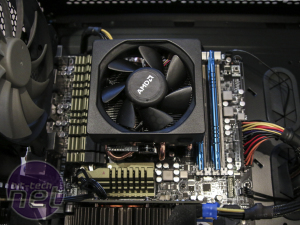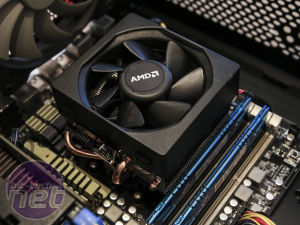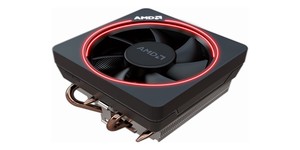
Performance Analysis
Strapped to our usual AMD AM3+ cooler test rig, the Wraith performed quite well, managing to match the SilverStone Argon AR01 when its fan was locked at full speed, with a delta T of 29°C. Admittedly, the Wraith was much noisier here so it's a clear example of where even modest air coolers that retail for £20-30 will perform the same or better and offer significantly lower noise levels.However, switching to PWM mode using our motherboards standard fan profile saw the noise dramatically reduced. In fact, other than a slight vibration and low level electrical hum, it was indistinguishable above our case fan noise, even under full load. By comparison, the stock cooled made a high pitched whine and very noticeable airflow noise at the same settings, which was just the same at 12V or PWM.
In PWM mode, though, the Wraith's delta T did rise to 33°C. While this matched much more expensive coolers, such as the Corsair Hydro Series H80i GT, the latter was again much quieter under full load. Still, this is an excellent result for a cooler that costs just $10 more than the bog standard stock cooler (hopefully the same or less in sterling too).
Click to enlarge
Pitched against the stock cooler, it was winning all round with far quieter noise levels across the board as well as significantly better cooling performance. At stock speed, it was a similar story at 12V and PWM, with around 7°C difference, but the Wraith was able to keep our overclocked FX-8370 in check - just, with a delta T of 50°C in PWM, while the stock cooler hit the limits with a delta T of 55°C. This equated to a software read-out temperature of 72°C, much above which the system would simply switch off.
Conclusion
With such a small price difference, the Wraith is absolutely worth the extra outlay over the standard cooler and we're confident in saying that this is the case whether you're overclocking or not. The difference in noise and cooling performance in both scenarios was dramatic, especially so when overclocking. Our reasonable overclock to 4.6GHz left the Wraith with plenty of headroom for those sticky summer days - impressive for a relatively simple air cooler that ships with a CPU and costs just $10 more.The stock cooler, by contrast, struggled and isn't really much good unless you're happy with constant redlining or throttling under constant, heavy loads. Even then, the Wraith was significantly quieter, so long as you use PWM mode with a low to medium fan profile. At maximum speed it can get pretty noisy, while the much quieter PWM mode and standard fan profile we used only saw temperatures rise a few degrees, yet it was comparatively pleasant to sit next to.
While AMD obviously needs to shake things up in terms of CPU performance, the Wraith kit is a great option if you have your heart set on the FX-8370 and allows for a modicum of overclocking too - not bad for what is essentially a very cheap cooler. Perhaps more importantly, it does so at much quieter noise levels than the stock cooler, although if money is less of a concern and you need to get the most out of your CPU in terms of overclocking to keep up with its Intel rivals, a third party cooler such as the Gelid Antarctica is definitely worth the money. Similarly, though, we doubt many coolers less than £20 would offer a significant performance boost over the Wraith.


MSI MPG Velox 100R Chassis Review
October 14 2021 | 15:04










Want to comment? Please log in.